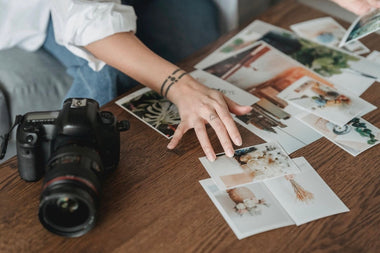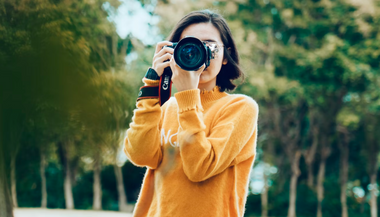One of the most important elements in a strong image is sharp focus. It is rare that an out of focus picture will hold the viewer’s attention for very long. Achieving sharp images can be tricky for any photographer, particularly beginners because there are so many elements and situations that can cause problems. So here are some ideas on how you can consistently achieve sharp photos.
1. Camera Holding Position and Technique:
If you find yourself in a situation where you’re forced to handhold your camera (no tripod available) a proper camera holding technique is critical for sharp photos. This is particularly true in low light situations, or when using a long zoom lens.
Keep your feet a shoulder width apart, keep your elbows into your body, hold your left hand under the camera lens (on a DSLR), hold your breath and gently squeeze the shutter button. Avoid a jabbing motion when pressing the shutter. For additional stability try leaning against a tree or wall.
2. Image Stabilization:
Some lenses have an image stabilization option which depending on the lens can add 2-4 stops of extra range that you can handhold. You may find that with image stabilization you can handhold a 200mm lens at 1/30th of a second which normally would be unlikely!
3. Focal Length Versus Shutter Speed:
A good general rule is to use a shutter speed equal or higher than your focal length. So for instance when shooting with a 200mm lens you would want to set a shutter speed of 1/200 or faster.
4. Capture Fast Action:
Make sure your shutter speed is fast enough to capture the action in front of you. So while you might be able to photograph a field at 1/60, that wouldn’t be fast enough if people were playing soccer on it!
Generally, 1/125 or 1/250 is good for people walking, but for any kind of faster sport or action, you might want to move up to at least 1/500 or preferably 1/1000 or faster. The photo below was taken at 1/4000th of a second.
5. For Portraits Focus on the Subject’s Eyes.
This is the critical area of focus for most portraits and the eyes must be sharp even if the rest of the photo is soft. If the subject’s face is turned then focus on the eye closest to the camera.
6. Adjust Your Aperture to Maximize Depth of Field.
For landscapes set a smaller aperture such as f11 or f16 and focus 1/3rd of the way into the scene. You can also use a hyperfocal distance chart phone app which will tell you where to focus based on your focal length and aperture. Properly setting your camera will enable you to have everything from the near foreground to infinity in focus.
7. Be Careful with Large Apertures.
Apertures such as 1.4, 1.8 and 2.8 have a narrower depth of field (the area in your image that is in focus). This becomes even more noticeable with longer zoom lenses. In these situations don’t recompose the shot after focusing because the change in distance from the camera sensor to your subject will cause soft images. Instead, keep your camera position steady and constant and move the focusing cursor around to select your focus point.
8.Macro Depth of Field:
When shooting with a macro lens you will get much less depth of field than with a normal lens. Meaning, less of your picture will be sharp. To help compensate use a smaller aperture such as f11, f16 or f22. Even then only a portion of your image will be sharp so focus carefully on the critical area of your photo that needs to be tack sharp.
9. Use Burst Mode:
This is another good trick for when you’re hand holding the camera and shooting a subject in low light. By firing off many photos per second in burst/continuous shooting mode you increase your chances of capturing a sharp image. This is more of a desperation technique so use the other tips first!
10. Use a Tripod:
By using a tripod you are stabilizing your camera and also opening up the possibility for extreme long exposure shots that would be impossible to handhold. Use a cable/remote release to fire the shutter so that you are not touching the camera with your hand and possibly causing camera shake. If you don’t have a cable release then use the self-timer.
11. Good Equipment and Maintenance:
Obviously having top quality lenses increases your chances of getting sharp images. But there are things you can do to help with any camera lens. Keep it clean, avoid putting cheap filters on your lens, and find the lens sweet spot which is often a stop or two away from your maximum aperture. You may find your lens is sharper in the f4 to f16 range than at f1.4 or f22. Experiment with test shots to see what works best with your equipment.
12. Use Post Production Sharpening.
Taking the photo is only half the battle! All photos can be improved later in post-production. By using photo software such as Photoshop, Lightroom, or ON1 Photo Raw 2018 you can sharpen either the entire image or with local adjustments select a certain area such as a person’s eyes.
Good luck and I hope these tips help you to create sharper photos. I highly recommend practicing with your equipment and taking notes so you can find out what works best for you. What tricks do you use to get sharper photos?








